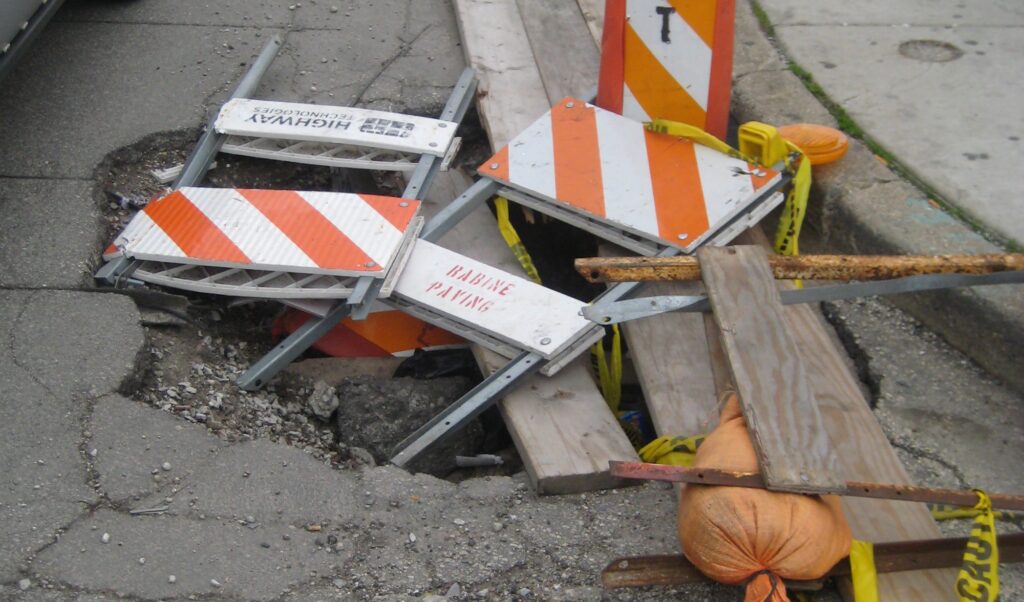When decision-makers fail to prioritize basic maintenance and repair, everyday Americans pay the price—in increased costs, increased time on the road, and suffering local economies. We can’t keep wasting taxpayer dollars without a clear plan to maintain what we’ve already built.

We’ve written a lot about how decision-makers justify spending money on expansions instead of repair, even when we have a $830 billion maintenance backlog on existing highways alone. The idea is that when they add a new lane, they are saving travelers time, primarily by allowing drivers to drive faster. If you’ve been following us for a while, you already know that this logic is fundamentally flawed, but let’s set that aside for a moment.
When we expand roadways at the expense of every other way to travel, we create a transportation system that all but requires owning and driving a personal vehicle for essential trips like going to work, school, or the grocery store. When we then fail to maintain those same roads and bridges, we see travel delays in the form of detours and slowed traffic—delays people must suffer through, because they have no other option.
Because the full transportation system is connected, when one intersection is rendered impassable due to poor maintenance, anyone traveling on the roadways around it can experience disruptions, even if those roads are in perfect condition. If time is money (as transportation officials like to believe), this is reason in itself to invest in more transportation options and maintain our existing infrastructure.
It gets worse
Infrastructure failures also have economic ripple effects. When bridges are closed due to maintenance concerns, changed routes can impact local businesses. Bridge collapses can cost local economies millions and disrupt national supply chains.
This doesn’t even factor in that every dollar we spend on expansion adds to our overall maintenance deficit, as new lanes and bridges have maintenance needs as well. And thanks to induced demand, new lanes often lead to more driving, which leads to even more wear and tear on our roads. These costs, too, will eventually be shouldered by taxpayers.
There are also real, physical costs to poorly maintained roads and bridges. When you don’t maintain the roof of your house, you end up with even more costs as water damages the interior. It’s the same with roads and bridges. Water percolates through cracked and potholed surface pavement leading to worse damage, leading to expensive rebuilds that could have been averted with proper resurfacing and minor repairs. Bridges that aren’t regularly cleaned, sealed and repainted have shorter lifespans leading to more frequent bridge replacements that are very expensive.
Costs accumulate for travelers as well. Driving over potholes risks damage to personal vehicles, which the city and state likely won’t pay. If pavement is in poor condition, risk of crashes can increase. And then there is the physical risk of driving over a poorly maintained bridge, hoping that it won’t collapse. When the Fern Hollow Bridge collapsed in Pittsburgh in 2022 due to lack of maintenance, a bus and six passenger vehicles fell with it, leading to multiple injuries. When a structurally deficient I-35 bridge collapsed in Minneapolis in 2007, 13 people died and 145 more were injured.
You could put it this way: The maintenance costs state and local decision-makers fail to address are all eventually passed on to everyday Americans—to travelers, local business owners, and workers. The costs accumulate in the form of lost time, lost income, damage to personal vehicles, and increased risk of injury. They turn into even more maintenance expenses and higher taxes down the line.
When taxpayer dollars aren’t spent responsibly, we all pay for it, over and over again.
We don’t have the money for this
The Infrastructure Investment and Jobs Act was a historic investment in our nation’s infrastructure, but without a requirement to fix it first, a substantial portion of those funds went to more roadway expansions without any plan to maintain the roads we’ve already built. The environmental impact alone of these expansions will likely lead to even more maintenance needs in the future.
It’s unlikely we’ll see an investment like that again any time soon, which makes our maintenance needs even more concerning. In the next federal infrastructure investment, congressional leaders need to make sure that taxpayer money gets spent wisely. We simply can’t afford to keep this up.
It’s Fix It First Week. Transportation for America has identified three key principles for the next federal investment in transportation and infrastructure: Invest in the Rest, Fix it First, and Safety over Speed. Why do they matter? Follow along with us over the next several weeks as we provide explanations and real-world examples of how these principles can help reshape U.S. transportation for the better. Learn more.
The post We can’t afford to keep avoiding repair appeared first on Transportation For America.











